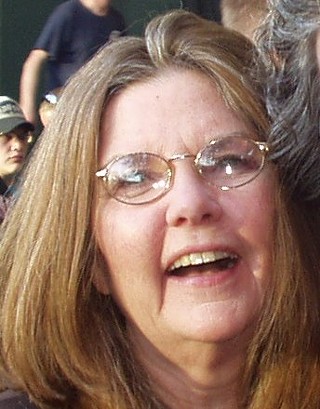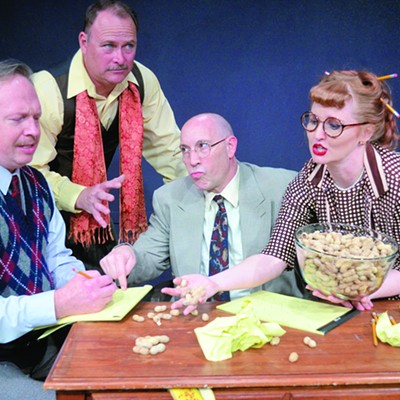
If Thomas Edison, or anyone else, despaired when his kinetoscope invention was exploited within five years by the next big thing, it was lost on early movie fans.
They flocked to the new kinetoscope “parlor” off Times Square to see the moving images with friends and family. That primordial multiplex featured 10 kinetoscopic “movies”, including one of a strongman client of Florenz Ziegfeld.
A relentless flow of innovations followed, representing humanity and its fables ever more realistically, and ultimately, fantastically. The history of movie theaters is a trail of invoices for updating technology.
For good or ill, we can now make our own movies, starring ourselves, in virtual reality fantasies of our own narration. Or we can go to the multiplex and see the latest sequel to a favorite super-hero’s story, even in 3-D.
Sadly, lots of art house cinemas have shuttered along the way. Yet this year marks The Loft Cinema’s 50th year of almost continuous success, built upon lucky and persistent traditions of gifted programming, talented leadership and the canny agility of a roadrunner.
Having just come through the COVID lockdown, The Loft’s darkest hours to date, Loft Marketing Director J.J. Giddings suggests that we still have every reason to don sunglasses for a look at its future.
“For some reason, the media has an obsession with the end of movie theaters,” says Giddings with a laugh. “It’s been happening since TV came out, even radio. When streaming started, it was ‘Who’s going to go to the movies?’ And our numbers were going up every single year, despite the doomsday scenarios.”
The Loft has had exceptional programming from the beginning. Its first programmer, Bob Campbell, went on to become president of the New York Film Critics Association. Early Loft Film Festival programmer Mike Plante is now Senior Programmer for Short Film at the Sundance Film Festival. Another early programmer, Gary Meyer, became a founder of the Landmark chain of art cinemas and the Art House Convergence, an affiliation of independent art houses. The Convergence has held conferences to encourage members to work together toward solutions to shared challenges. An ongoing listserv keeps the conversations going
Giddings says the Convergence especially helped theaters walk each other through the transition from 35 mm to digital distribution in the early 2000s. Thirty-five millimeter had been the standard gauge since 1917. The average movie required shipping five 100-pound cannisters to the next destination.
Switching to digital all but zeroed out physical distribution logistics, but art houses paid dearly to overhaul their entire projection systems and retrain staff.
The Loft Cinema became a nonprofit entity in 2002, just in time. Executive Director Peggy Johnson says, “Grant funding, sponsorships and major gifts have taken us over the ups and downs.”
Johnson says, that besides making the theater more sustainable, nonprofit status amped up its visibility.
In 2015 the Loft became a member of CICAE (International Confederation of Art Cinemas), an organization that endows awards to exceptional art films at festivals around the world. The same year, Johnson was elected the first American ever to serve on the board of the CICAE.
Then The Loft Film Festival became a festival member of CICAE, lifting Tucson to the ranks, if not quite yet the stature, of Cannes and Telluride. The Loft Film Festival, this year set for October 12-20, now routinely hosts international CICAE jurors to judge and present awards to films screened at the Tucson event.
Although Johnson heads up The Loft, she is quick to credit the savviness of its program director, Jeff Yanc, and the singular reputation he’s achieved in the art-house world.
“Everybody in the industry knows him, and they know that it matters to know him,” she says. “He’s really a key to our success.”
Yanc earned a master’s degree in film history from the University of Arizona, but then devoted his work life to books, running the popular Readers Oasis bookstore in Rancho Center. Located across the street from The Loft, Rancho Center is now home to Whole Foods and the Loft office.
Yanc considered leaving Tucson when he closed the bookstore. “Then I thought, is there anything I really want to do here?” he recalls. “I love The Loft. I’ll volunteer.”
On the afternoon in 2006 when he locked the bookstore behind him, he walked across the street to talk to Johnson. Maybe he could do lectures or organize events, he thought. But instead, Johnson offered him a job.
“Coincidentally, their program director had just left,” Yanc remembers. “I just started right away. I didn’t even take a day off. It took off like a rocket because there weren’t a lot of rules yet. It had just become a nonprofit.”
Yanc says the challenge of programming the Loft’s films and events is to fill three theaters that operate at least 12 hours a day 365 days a year. That scale helps drive the theater’s financial success. It generates economies in operations, and continuity of staffing, that aren’t available to art houses that open for a handful of shows a week. It also gives The Loft leverage with producers and distributors.
When he started, though, “The theater was still struggling to find an audience,” Yanc says. “So we just decided to try everything. We found by process of elimination things that brought people in. We did a lot of one-night events, ran films for one week and then changed, singalongs, interactive events. It is exciting, finding what works and giving things time to find an audience. That’s the magic of an independent art house, because you’re not relying on one movie, like a Top Gun: Maverick, to fund your whole theater.”
With agility and creativity, the Loft has even been able to leverage multiplex megahits into the theater’s own programming,
“A good example of this,” Yanc says, “is Everything Everywhere All At Once. Right now it is our No. 10 highest grossing film ever. It’s been the No. 1 run all over Tucson for eight weeks. It’s a great film, but also it really spoke to a lot of different audiences, young people, older people, the Asian American community, people who just like weird, fun movies.”
We can almost imagine cartoon dollar signs in the eyes of the Loft programming team as they spun out a series of movies by Everything, Everywhere star Michelle Yeoh. Then they booked Swiss Army Man, the first film by the directors of Everything, Everywhere. “And let’s show The Goonies,” Yanc says, “because the kid in the Goonies grew up and now he’s co-starring in Everything Everywhere.”
Yanc’s sensitivity to Asian-American community’s response reflects a drive toward inclusivity that’s long been another hallmark of Loft programming. He shares a story about his current efforts to bring the Navajo translation of Finding Nemo. Nemo and Star Wars were the first in what was to be a series of Disney films translated to Navajo.
After sorting out what Yanc says were “a lot of legal entanglements,” The Loft screened Star Wars earlier this year. “The audience was packed, primarily with indigenous folks. It was a fun moment when everyone laughed the first time they heard Han Solo speaking Navajo.” Yanc says.
“We had been trying to get that film for years. When certain audiences see themselves represented in a film, we’ve found a lot of gratitude for that. We have tons of examples like that of films that really speak meaningfully to communities.”
Those who appreciate Japanese culture may join animation fans in following the Studio Ghilbi Summer series continuing through September 4. The animated features, in the original Japanese, were created by the award-winning father-son team of Hakayo and Goro Miyazaki. Viewers may choose either dubbed or subtitled versions.
Yanc says kids’ programming has generated a large following among Tucson families. Kids shows are a party as much as a film screening. They include activities, appearances by personalities and, often, something for everyone to take home. This year’s Loft Kids Fest is set for every Saturday and Sunday morning in July.
Loft series can also speak to offbeat communities of interest. “The Mondo Monday series is specifically built around artistically failed films (and those who love them),” Yanc says. “They’re literally, entertainingly bad movies, like Planet Nine From Outer Space.” Cult movie fans, too, have their own series, the popular Cult Classics on Friday and Saturday nights at 10 p.m.
The longest-running Loft series is the monthly Essential Cinema. Reflecting on its success, Yanc says, “That didn’t like take off immediately, but then people started to expect great, classic films coming every month, and it’s free.” Throughout 2022, the series shows movies that attracted the largest audiences in the theater’s first half century.
Yanc says free programming is a big part of the Loft’s mission to serve the community. Nonprofit status makes underwriting possible through grants and sponsorships. A grant from the National Endowment for the Arts, for instance, paid for the Loft’s Solar Cinema Van. Its inflatable screen and solar-powered sound and projection system allow the Loft to show movies throughout Southern Arizona.
“We reach out to communities and ask if there is any space where people would be interested in having us come show a film. We recently went to an art gallery in Nogales and showed a documentary about butterflies and how the border wall is affecting their ecosystem. There’s research going on down there about that.”
Now, the theaters are open, much of the regular programming has returned and the outlook is promising. But The Loft is not yet in the same place it was in 2019.
According to Johnson, “2019 was the best year ever. We had almost 250,000 tickets sold, and I think our income was over $3 million.” At that time, she was optimistic enough about the future to work with an architect and meet with a bank about building out some long-planned new construction.
By March of 2020, though, the Loft was reeling like the rest of us, without a clue what was next.
They found a stockpile of love and respect among Tucson’s community of film fans, and influential, well-heeled supporters the world over. “People were very generous,” says Johnson. “In the beginning they renewed their memberships and gave donations (that enabled us) to ride out the first few months of the pandemic.
“Then the federal PPP (Paycheck Protection Program) really helped. We got more from the SBA’s Shuttered Venues Operators Grant. That was a really big shot in the arm.”
The Loft programming team set up a theater of pay-per-view streaming films, accessible from its website. The interface was wonky, though, and, while many used it, there emerged no loyal, let alone sizeable, audience. Once the Loft’s theaters re-opened in May, 2021, its digital participation dropped to zero.
What did work were outdoor movies in the back parking lot. Everyone brought chairs and gathered around a screen built on the north-facing wall of Theater 1. “People loved it,” Yanc says. “They were so grateful. It was 2020 during the height of COVID, and we were doing socially distanced seating and still requiring masks outdoors. But everyone was just hungry to see other people and share the experience.”
When the Loft began opening theaters for live screening, entirely within CDC guidelines, Loft staff quickly gauged a trend. Yanc says, “It became clear that young people weren’t afraid to come back.” The programming team immediately began offering movies and events pitched to that demographic,
“The older audience was one of our biggest demographics.” Yanc says. “It’s a more compromised demographic, and a big question in our industry has been ‘Will that older audience come back?’ They’ll come back for a Downton Abbey, but will they come back consistently?”
As favorite series and special events return, and new programming is being road-tested, Johnson naturally regards filling seats as paramount. “Right now, we’re just hoping that the film industry can stabilize, and we can start getting back to close to where we were on our box office,” she says. “We are still making a fraction of what we made.”
But she also sees this downtime as an opportunity. Construction might disrupt capacity, anyway. Why not get it under way when attendance is still recovering?
“We had this big vision around 2009,” she says. “Then we got real. Instead of baking a big cake, we decided to bake cookies. So we bought the auto place next door and made it screen three, and then we renovated screen one and the marquee. We bought the big north parking lot and paved it. We repaved everything and brought everything up to code. We covered the parking lot with solar panels.
“Those are all the little cookies we’ve been baking for 10 years,” Johnson says. “Now we’re barreling ahead to finish the entire project. It will be as streamlined as I can make it. Nice, but I just want it to be functional and feel like an authentic Tucson place, you know?”
To expand on Johnson’s metaphor, we can think of the build out as the milk for her cookies. The new construction will increase the theater’s functionality and versatility, but it won’t increase seating capacity. She says the campus actually will lose 15 seats, but that could help resolve a problem. Upstairs, theater 2, which has never been fully accessible, will be converted into the Loft office, eliminating the overhead of maintaining their office off site.
A new 60-seat theater will go into the patio space behind theater 2. Then the open space between Theaters 1 and 2 will be reconfigured as an outdoor event space, which the Loft can use or rent out. One wall will feature a screen for future outdoor movies, freeing up the parking spaces formerly used for outdoor seating.
The entrance, refreshment area and new bathrooms will occupy a low-slung unifying addition across the campus’ front along Speedway Blvd. Johnson expects the build-out to be complete by 2024.
With theater and audience development under way, the Loft seems to be controlling what it can control to attract audiences and navigate the dynamics of its industry. Giddings, who, with Johnson and Deputy Director Zach Breneman, is also a member of Yanc’s programming team, has the confidence of an experienced hand. “We’ve had the same team doing programming for over 10 years and we show over 500 movies a year. So we have a pretty good idea of what our people are into,” he says. “A lot of people are already coming back. Even with (major) first-run films available, people still come out for the events and our unique programming.”
Yanc is realistic. “Audience expectations and their movie-going patterns changed drastically in two years. Our challenge now is to get people back into the habit of going to theaters.”
Asked whether they anticipated a Loft presence in streaming, both Johnson and Yanc said, simply, “No”. Johnson says, “I really take a lot of pride in how good our picture is and how good our sound is and how much attention we pay to that. I think that’s one of the things that makes an art house different.”
Yet she doesn’t entirely rule out virtual reality. “We had virtual reality at our 2019 film festival. It was brilliant. That’s becoming a really big part of a lot of festivals. Some even have competitive virtual reality programs.”
But she notes that, like streaming, “It’s an individual experience, and going to a film is a community experience.”
Yanc thinks that film production itself may be holding audiences back. “The number of films being made now has dropped because of the pandemic.” Until the film industry can generate enough movies, Yanc et al can recombine and re-bundle dozens of series from more than a hundred years of global film output. But there are other models on the sidelines, too.
Consider the Loft’s First Friday shorts events. They’re like a poetry slam for short, mostly amateur films. The audience screams, laughs and groans, ultimately demanding, or not, that a giant gong be sounded to put them out of their misery.
Entrants are often, but not necessarily, affiliated with the UA Film School. The films are remarkable: funny, awkward, thoughtful and in flashes, brilliant. They mostly use minimal, often single-room sets, featuring fewer than five actors, but it’s the technology that shines. Deft camera effects, radical angles, post-production tinkering and visual overdubs varying in speeds, colors and images can create moods and underscore the action. Good or terrible, the entries share the daring energy of innovation.
It’s all going somewhere new, and it’s been on that road for some time. Consider the 2015 full-length feature Tangerine. Filmed entirely on three iPhone 5s Smartphones, it was nominated for 46 prestigious awards.
And virtual reality pods turn up in rooms at film festivals, echoing the original kinetoscope parlor where people engaged their brains and eyeballs in fun things, separately together.
Meanwhile, Etsy has several vendors offering vintage kinetoscopes, zoescopes and flip books that create illusions of motion. There’s even a reproduction of a flip book featuring a Felix the cat cartoon by its creator, Pat Sullivan.
Moving pictures will always be with us.














